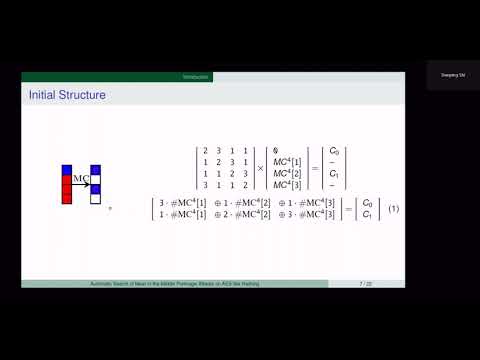| Authors: |
- Zhenzhen Bao , Division of Mathematical Sciences, School of Physical and Mathematical Sciences, Nanyang Technological University, Singapore
- Xiaoyang Dong , Institute for Advanced Study, BNRist, Tsinghua University, Beijing, China
- Jian Guo , Division of Mathematical Sciences, School of Physical and Mathematical Sciences, Nanyang Technological University, Singapore
- Zheng Li , Faculty of Information Technology, Beijing University of Technology, Beijing, China; Beijing Key Laboratory of Trusted Computing, Beijing University of Technology, Beijing, China
- Danping Shi , State Key Laboratory of Information Security, Institute of Information Engineering, Chinese Academy of Sciences, Beijing, China; University of Chinese Academy of Sciences, Beijing, China
- Siwei Sun , State Key Laboratory of Information Security, Institute of Information Engineering, Chinese Academy of Sciences, Beijing, China; University of Chinese Academy of Sciences, Beijing, China
- Xiaoyun Wang , Institute for Advanced Study, BNRist, Tsinghua University, Beijing, China; Key Laboratory of Cryptologic Technology and Information Security, Ministry of Education, Shandong University, Shandong, China
|
| Abstract: |
The Meet-in-the-Middle (MITM) preimage attack is highly effective in breaking the preimage resistance of many hash functions, including but not limited to the full MD5, HAVAL, and Tiger, and reduced SHA-0/1/2. It was also shown to be a threat to hash functions built on block ciphers like AES by Sasaki in 2011. Recently, such attacks on AES hashing modes evolved from merely using the freedom of choosing the internal state to also exploiting the freedom of choosing the message state. However, detecting such attacks especially those evolved variants is difficult. In previous works, the search space of the configurations of such attacks is limited, such that manual analysis is practical, which results in sub-optimal solutions. In this paper, we remove artificial limitations in previous works, formulate the essential ideas of the construction of the attack in well-defined ways, and translate the problem of searching for the best attacks into optimization problems under constraints in Mixed-Integer-Linear-Programming (MILP) models. The MILP models capture a large solution space of valid attacks; and the objectives of the MILP models are attack configurations with the minimized computational complexity. With such MILP models and using the off-the-shelf solver, it is efficient to search for the best attacks exhaustively. As a result, we obtain the first attacks against the full (5-round) and an extended (5.5-round) version of Haraka-512 v2, and 8-round AES-128 hashing modes, as well as improved attacks covering more rounds of Haraka-256 v2 and other members of AES and Rijndael hashing modes. |

